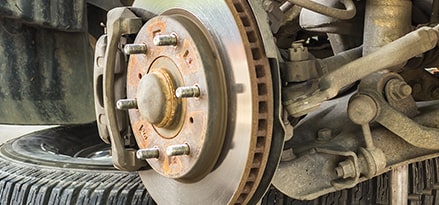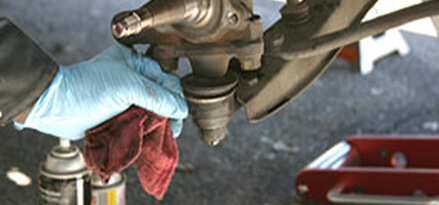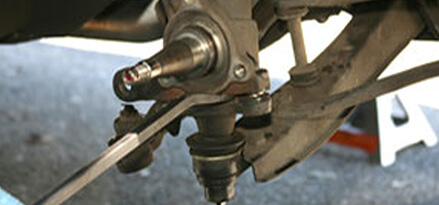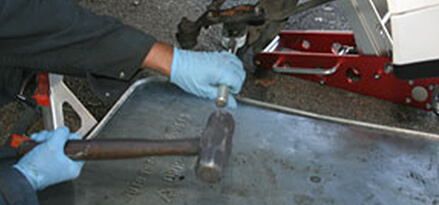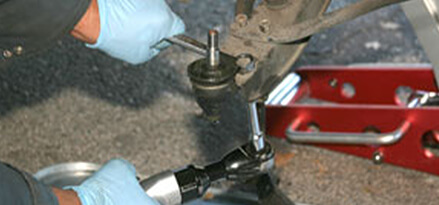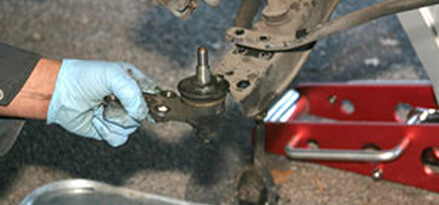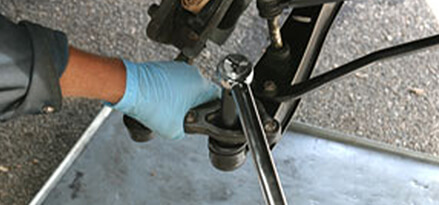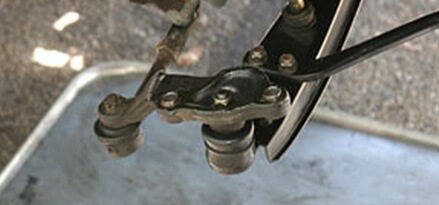By Mike Bumbeck,
Believe it or not, a key feature of our grand human design has made it into the suspension of almost every automobile on the road today. Like the ball and socket joint that connects your leg bone to your hipbone, so goes the ball and socket joint (or joints) that holds the front suspension of your vehicle together. In the same way that your leg can move up and down, and side to side, the automotive ball joint enables the wheel and suspension to move together in the same manner.
Connections
The automotive ball joint connects the control arm to the steering knuckle. While the control arm allows for up and down motion, the steering knuckle turns the wheels when you turn the steering wheel. This is important because steering would not be too effective if the front wheels were not able to travel with varying demands created by even more diverse road surfaces and loads placed upon the suspension itself. Because the ball joint can move in two different directions at once, the suspension can, too.
Depending on the type of vehicle and suspension in question, there may possibly be an upper and a lower ball joint. The lower ball joint usually takes the biggest hits and wears out first. Not only does it need to handle the load of the vehicle, but it also absorbs the shocks of potholes and other bone-jarring road hazards. It is for these reasons that ball joints should be lubricated and inspected according to proper service schedule intervals.
"Enough cannot be said about torque when dealing with suspensions. A bolt that has been properly torqued is not one that's just ‘tight enough.’ Torque holds the fastener at a tension that allows the fastener to adequately keep things together and flex to a certain extent."
Inspecting your front suspension and ball joints
The time for regularly scheduled lubrication is the best time for front suspension maintenance and ball joint inspection. First look to see that the rubber boots holding the grease inside the ball joint are in good shape. If the boot is torn, or just plain gone, chances are so is the ball joint. If the ball joint is capable of being greased, use only the grease that is recommended for the job. Some ball joints come lubricated for life and are therefore incapable of being greased – the paradox though is that they don't usually live very long.
Worn ball joints can be held accountable for clunks and sloppy steering. As the socket and ball wear out together, the tolerances become greater and the ball joint becomes loose. The ball can literally rattle and clunk around in the socket – causing clunking noises. On the other side of the wear equation, the ball joint can bind and cause a tight spot in steering travel. Replacing the ball joints can bring smooth steering back to your old clunker.
Determining if the ball joints are good or bad depends largely on which type of suspension and ball joints are used in the vehicle in question. If you're lucky, the ball joints will have wear indicators built right in, in which case, checking them is easy. If not, relieve the load on the suspension by jacking the vehicle up and inspecting each individual ball joint for play. As there are more than a few types of suspension setups out there, the best procedure to follow is the one that's spelled out in your vehicle's service manual. As severe failure of a ball joint can cause a car's suspension to come apart, it is best not to take guesses when dealing with suspension issues.
Wear out
While all automotive ball joints more or less perform the same task, there are many different designs out there. Some are exceedingly simple yet require liberating most of the suspension for replacement. Other types of ball joints are of the press-in variety and require specialized tools for proper installation. Certain ball joints are of the screw-in variety and require not only a giant unique socket but also the strength of Gorilla Monsoon himself to remove and replace.
While pictures or illustrations will help a great deal in navigating through the maze of front suspension components, keep in mind that every vehicle is different. It is therefore crucial to acquire a service manual or auto repair manual specific to your vehicle before beginning work on an unfamiliar suspension. Blowing the suspension apart with a pickle fork and figuring it all out later can leave you stuck in a major pickle. Knowing that a special socket or tool needs to be used to remove or install the ball joint before dismantling the entire suspension can save time and money. The good news is that many parts houses now offer specialized suspension tools for rent with deposit and sell service manuals along with parts.
Enough cannot be said about torque when dealing with suspensions. A bolt that has been properly torqued is not one that's just "tight enough." Torque holds the fastener at a tension that allows the fastener to adequately keep things together and flex to a certain extent. Too little torque and the fastener can come apart; too much torque and the fastener can shear and fail – not at all a good thing to happen while hurtling down the road. Always use a torque wrench during final suspension assembly. Finally, always leave one side of the vehicle assembled for reference when tackling any suspension issues.
How-to tips
The following are a few car maintenance tips on how to replace ball joints. Please make sure to follow your owner’s service manual recommendations.

